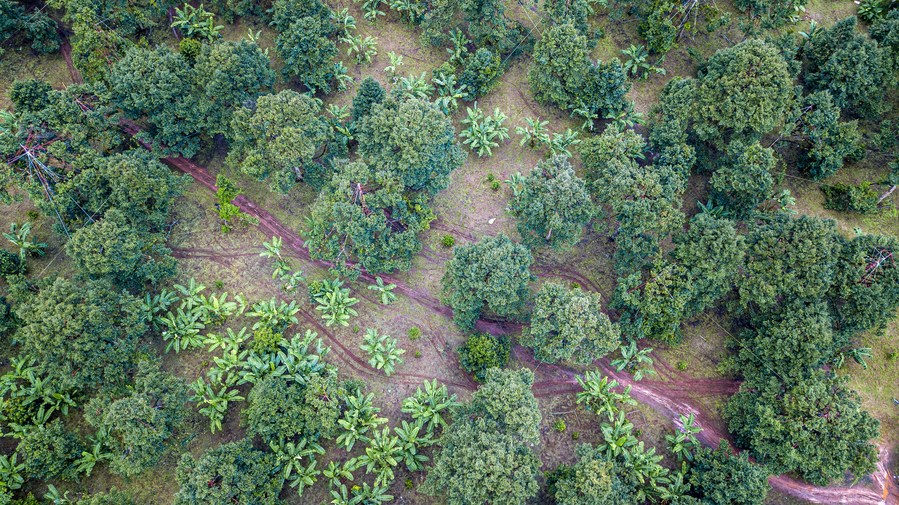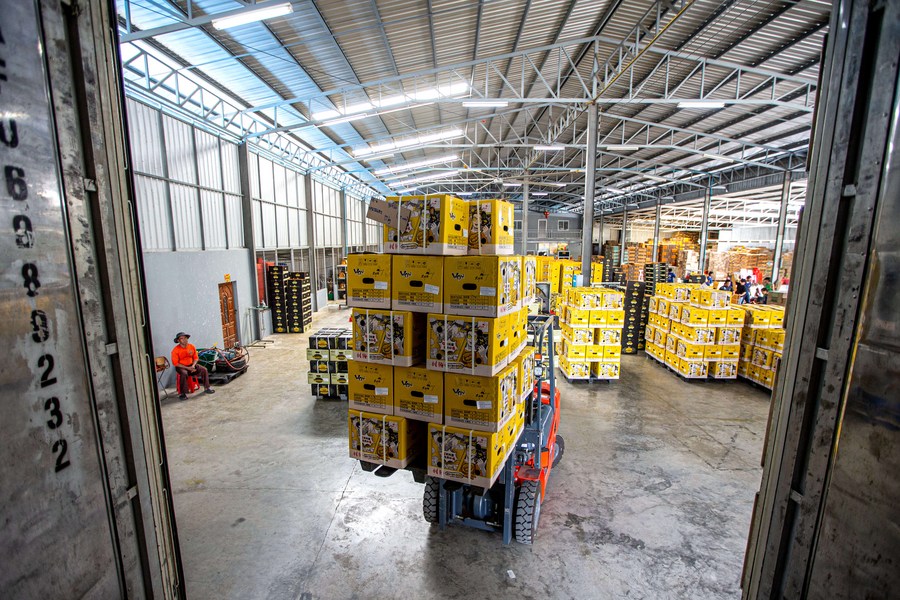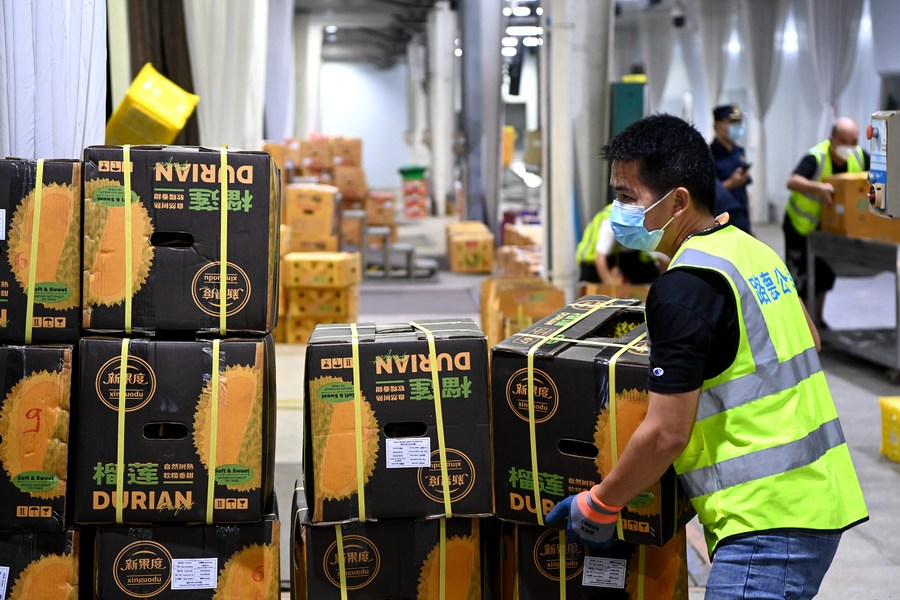
Beijing, Sept. 23 (Xinhua) Known as the king of fruits in Southeast Asia, durian is gaining popularity among Chinese consumers due to its rich texture and unique taste.
The high cost of durians has kept many people from indulging in its delights over the years. However, the decline in the price of the iconic thorny fruit of the Southeast Asian country is now bringing joy to a large community of durian lovers.

An employee of a fruit trading company hands out an open durian, imported from Vietnam, in Pingxiang, south China’s Guangxi Zhuang Autonomous Region, May 19, 2023. (Xinhua/Hu Xingyu)

A woman selects durian fruits imported from Thailand at a supermarket in Nanning, south China’s Guangxi Zhuang Autonomous Region, on September 7, 2023. (Xinhua/Hu Xingyu)
A visitor (L, front) selects durian imported from Vietnam during the 20th China-ASEAN Expo at the Nanning International Convention and Exhibition Center in Nanning, capital of south China’s Guangxi Zhuang Autonomous Region, on September 17, 2023. (Xinhua/Gao Yiming)
Traders from Vietnam sell durians during the 20th China-ASEAN Expo at the Nanning International Convention and Exhibition Center in Nanning, capital of South China’s Guangxi Zhuang Autonomous Region, on September 18, 2023. (Xinhua/Zhang Ailin)
Durian-flavored sweets are pictured at a snack shop in Nanning, south China’s Guangxi Zhuang Autonomous Region, on September 17, 2023. (Xinhua/Hu Xingyu)
Sep. 12, 2023, a worker picks durian fruits for mail order at a market in Pingxiang, south China’s Guangxi Zhuang Autonomous Region. (Xinhua/Gao Yiming)
Abundant harvests of durian fruits in Southeast Asian countries, as well as tariff-free policies and expanded market access under the framework of China-ASEAN Free Trade Area and Regional Comprehensive Economic Partnership (RCEP) can be attributed to these changes.
According to Thailand’s Ministry of Commerce, China was the largest export market for Thai durians in 2022, accounting for more than 96 percent of the total export volume, with a total value of US$3.09 billion.
This aerial photo taken on Sept. 18, 2023 shows a durian orchard in Sumphon, Thailand. (Xinhua/Wang Deng)
A worker cuts durian fruits from a tree at an orchard in Sumphon, Thailand on September 18, 2023. (Xinhua/Wang Deng)
A worker waits to pick durian fruits cut from the tree at an orchard in Sumphon, Thailand on September 18, 2023. (Xinhua/Wang Deng)
A worker holds a durian cut from a tree at an orchard in Sumphon, Thailand on September 18, 2023. (Xinhua/Wang Deng)
Workers load freshly harvested durian fruits at an orchard in Sumphon, Thailand on September 18, 2023. (Xinhua/Wang Deng)
Workers check freshly harvested durian fruits at a durian factory in Sumphon, Thailand on September 19, 2023. (Xinhua/Wang Deng)
Packed durians are loaded onto a truck at a durian factory in Sumphon, Thailand on September 19, 2023. (Xinhua/Wang Deng)
An employee loads packed durian fruits into a truck at a durian factory in Sumphon, Thailand on September 19, 2023. (Xinhua/Wang Deng)
In 2022, Vietnamese durians, known for their long harvest season and low prices, gained market access to China under the RCEP framework.
Thanks to durians entering the Chinese market, Vietnam earned more than US$500 million from durian exports in the first five months of the year, 18 times more than a year ago, official data from Vietnam showed. Vietnam exported more than 65,000 tons of durians during this period, with China buying 97 percent of exports.
Sep. 15, 2023 A farmer harvests durian fruits at a durian orchard in Duc Lak province, Vietnam. (Photo by Pham Dinh Duc/Xinhua)
Sep. 15, 2023, a farmer pre-cleans freshly harvested durian fruits at a durian orchard in Duc Lak province, Vietnam. (Photo by Pham Dinh Duc/Xinhua)
Sep. 15, 2023 Workers unload and sort durians at a durian processing plant in Duc Luk province, Vietnam. (Photo by Pham Dinh Duc/Xinhua)
Sep. 15, 2023 Workers clean fresh durian fruits at a durian processing plant in Duc Luk province, Vietnam. (Photo by Pham Dinh Duc/Xinhua)
Sep. Workers pack durian fruits for export to China at a durian processing plant in Duc Luk province, Vietnam on 15, 2023. (Xinhua/Hu Jiali)
Sep. 15, 2023 Fresh durians packed await delivery at a durian processing plant in Duc Luk province, Vietnam. (Xinhua/Hu Jiali)
In the first five months of this year, Guangxi imported 3.66 billion yuan worth of fruit from ASEAN countries, up 194 percent year-on-year. According to customs data, one of the notable increases was durian, which increased by 516 percent from the same period last year.
This aerial photo taken on Sept. 9, 2023 shows a view of the Friendship Pass Port in Pingxiang, south China’s Guangxi Zhuang Autonomous Region. (Xinhua/Gao Yiming)
This aerial photo taken on July 22, 2023 shows the automated container terminal of Beibu Bay Port in Qinzhou, south China’s Guangxi Zhuang Autonomous Region. (Xinhua/Gao Yiming)
Sep. Customs personnel check imported durians at the Port of Friendship Crossing in Pingxiang, South China’s Guangxi Zhuang Autonomous Region, 12, 2023.(Xinhua/Gao Yiming)
Sep. An employee moves durians awaiting custom clearance at the Friendship Crossing Port in Pingxiang, south China’s Guangxi Zhuang Autonomous Region, 12, 2023. (Xinhua/Gao Yiming)
Sep. 12, 2023, an employee (L) processes custom clearance documents at the port of friendship in Pingxiang, south China’s Guangxi Zhuang Autonomous Region. (Xinhua/Gao Yiming)
This photo taken on Sept. 12, 2023 shows a batch of durians waiting for customs clearance at the Friendship Crossing Port in Pingxiang, south China’s Guangxi Zhuang Autonomous Region. (Xinhua/Gao Yiming)
The „King of Fruits” has emerged as an important symbol of growing China-ASEAN cooperation and China’s vast market opportunity. Let’s look forward together as cooperation between China and ASEAN countries continues to deepen, and high-quality fruits from ASEAN countries become more affordable for Chinese consumers.■

. „Gracz. Namiętny pionier w mediach społecznościowych. Wielokrotnie nagradzany miłośnik muzyki. Rozrabiacz”.

























